Business Professional Development: Self-Assessment Report and Analysis
VerifiedAdded on 2023/06/05
|17
|3967
|83
Report
AI Summary
This report provides a comprehensive self-assessment of the author's strengths and weaknesses, exploring various aspects of business professional development. It begins with a personality assessment using the Myers-Brigg Type Indicator (MBTI), identifying the author as an ENTP. The report then delves into the author's values, goals, expectations, and needs, covering terminal, instrumental, organizational, and cultural values. It explores motivational theories, including Maslow's Hierarchy of Needs, McGregor's Theory X and Y, Locke's Goal Setting, and Hertzberg's Two-Factor Theory. The report further examines emotional intelligence, emotional labor, and the myth of rationality, followed by an analysis of leadership styles, theories, and aspirations, with a focus on democratic leadership. Finally, the report covers concepts of power, politics, influence, problem-solving, and decision-making, offering a holistic view of the author's professional development journey.
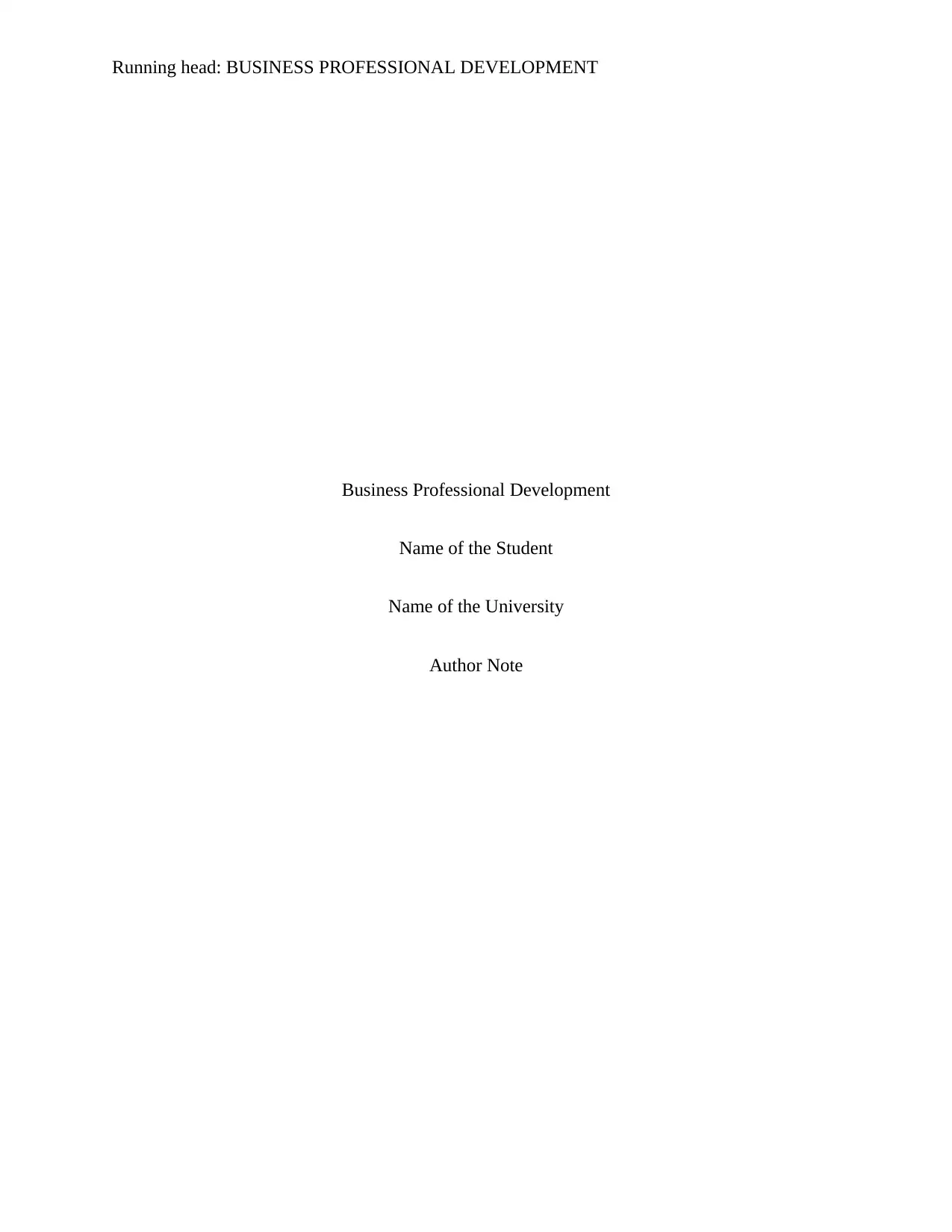
Running head: BUSINESS PROFESSIONAL DEVELOPMENT
Business Professional Development
Name of the Student
Name of the University
Author Note
Business Professional Development
Name of the Student
Name of the University
Author Note
Paraphrase This Document
Need a fresh take? Get an instant paraphrase of this document with our AI Paraphraser
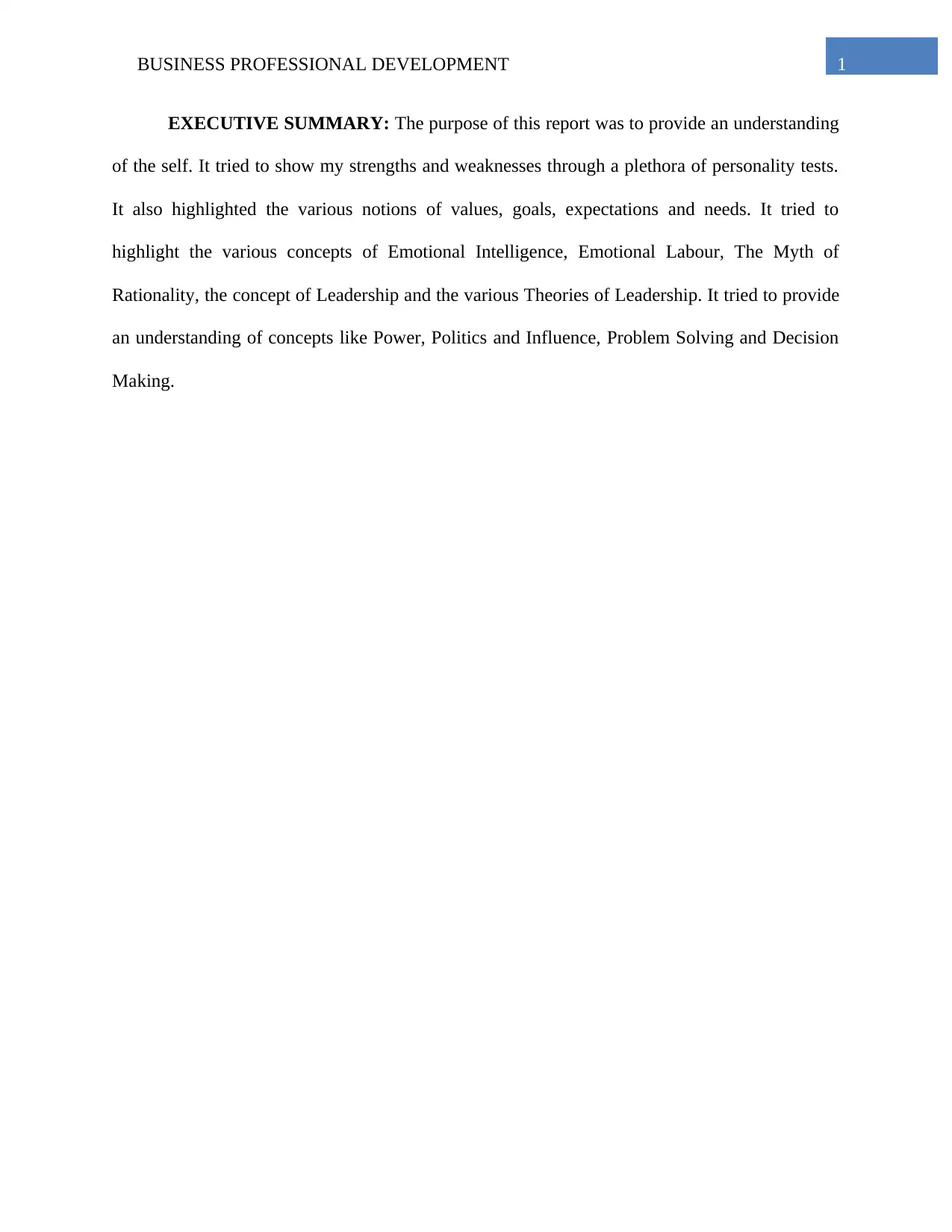
1BUSINESS PROFESSIONAL DEVELOPMENT
EXECUTIVE SUMMARY: The purpose of this report was to provide an understanding
of the self. It tried to show my strengths and weaknesses through a plethora of personality tests.
It also highlighted the various notions of values, goals, expectations and needs. It tried to
highlight the various concepts of Emotional Intelligence, Emotional Labour, The Myth of
Rationality, the concept of Leadership and the various Theories of Leadership. It tried to provide
an understanding of concepts like Power, Politics and Influence, Problem Solving and Decision
Making.
EXECUTIVE SUMMARY: The purpose of this report was to provide an understanding
of the self. It tried to show my strengths and weaknesses through a plethora of personality tests.
It also highlighted the various notions of values, goals, expectations and needs. It tried to
highlight the various concepts of Emotional Intelligence, Emotional Labour, The Myth of
Rationality, the concept of Leadership and the various Theories of Leadership. It tried to provide
an understanding of concepts like Power, Politics and Influence, Problem Solving and Decision
Making.
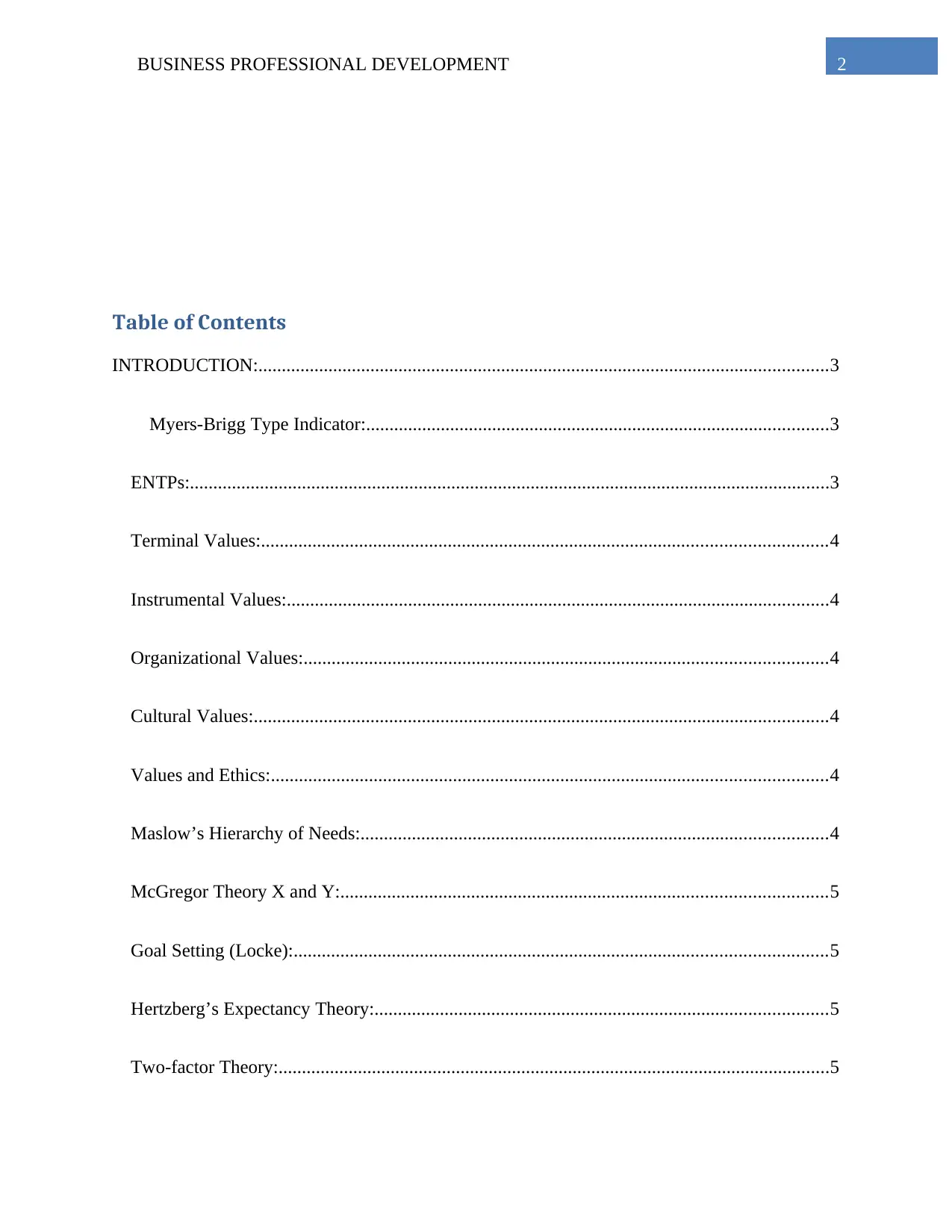
2BUSINESS PROFESSIONAL DEVELOPMENT
Table of Contents
INTRODUCTION:..........................................................................................................................3
Myers-Brigg Type Indicator:...................................................................................................3
ENTPs:.........................................................................................................................................3
Terminal Values:.........................................................................................................................4
Instrumental Values:....................................................................................................................4
Organizational Values:................................................................................................................4
Cultural Values:...........................................................................................................................4
Values and Ethics:.......................................................................................................................4
Maslow’s Hierarchy of Needs:....................................................................................................4
McGregor Theory X and Y:........................................................................................................5
Goal Setting (Locke):..................................................................................................................5
Hertzberg’s Expectancy Theory:.................................................................................................5
Two-factor Theory:......................................................................................................................5
Table of Contents
INTRODUCTION:..........................................................................................................................3
Myers-Brigg Type Indicator:...................................................................................................3
ENTPs:.........................................................................................................................................3
Terminal Values:.........................................................................................................................4
Instrumental Values:....................................................................................................................4
Organizational Values:................................................................................................................4
Cultural Values:...........................................................................................................................4
Values and Ethics:.......................................................................................................................4
Maslow’s Hierarchy of Needs:....................................................................................................4
McGregor Theory X and Y:........................................................................................................5
Goal Setting (Locke):..................................................................................................................5
Hertzberg’s Expectancy Theory:.................................................................................................5
Two-factor Theory:......................................................................................................................5
⊘ This is a preview!⊘
Do you want full access?
Subscribe today to unlock all pages.

Trusted by 1+ million students worldwide
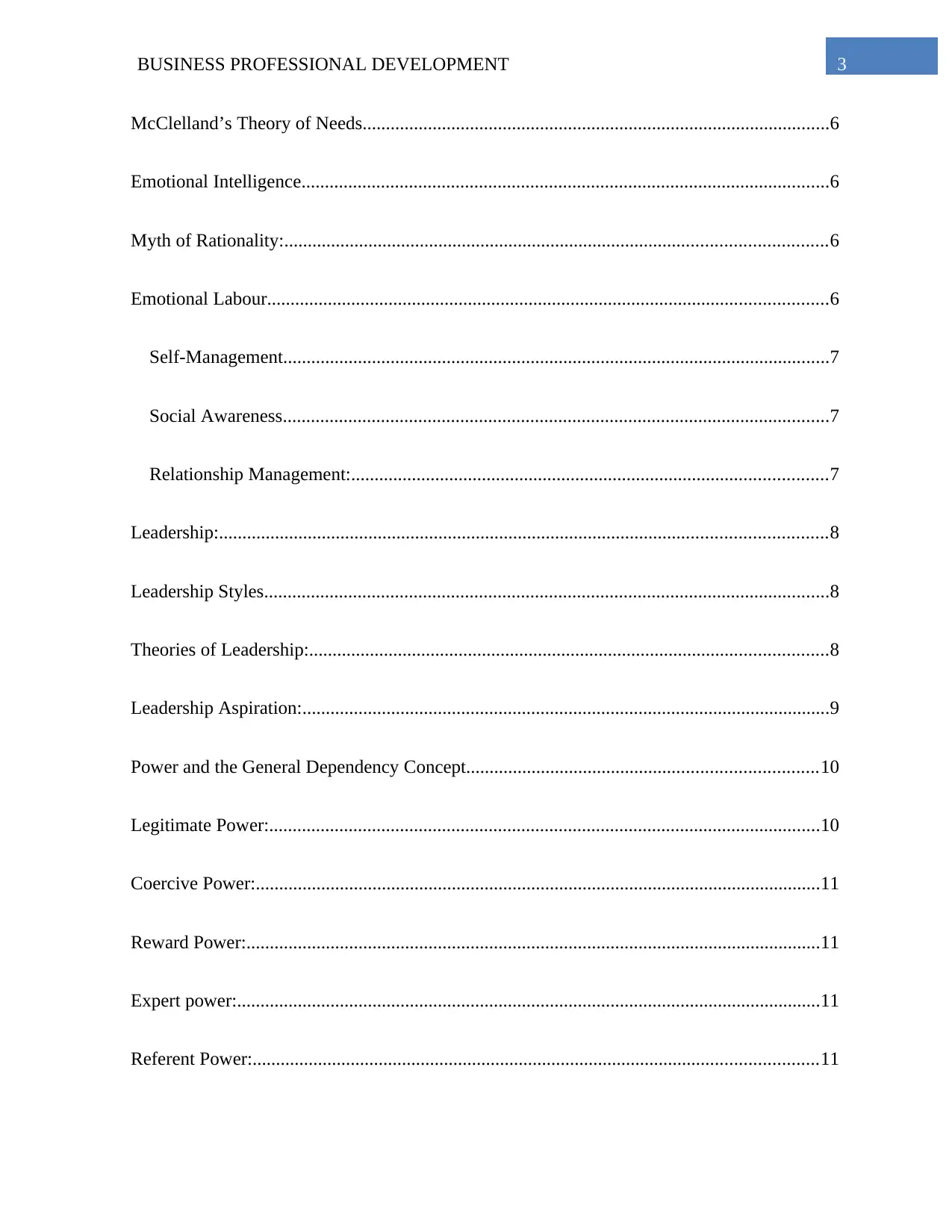
3BUSINESS PROFESSIONAL DEVELOPMENT
McClelland’s Theory of Needs....................................................................................................6
Emotional Intelligence.................................................................................................................6
Myth of Rationality:....................................................................................................................6
Emotional Labour........................................................................................................................6
Self-Management.....................................................................................................................7
Social Awareness.....................................................................................................................7
Relationship Management:......................................................................................................7
Leadership:..................................................................................................................................8
Leadership Styles.........................................................................................................................8
Theories of Leadership:...............................................................................................................8
Leadership Aspiration:.................................................................................................................9
Power and the General Dependency Concept...........................................................................10
Legitimate Power:......................................................................................................................10
Coercive Power:.........................................................................................................................11
Reward Power:...........................................................................................................................11
Expert power:.............................................................................................................................11
Referent Power:.........................................................................................................................11
McClelland’s Theory of Needs....................................................................................................6
Emotional Intelligence.................................................................................................................6
Myth of Rationality:....................................................................................................................6
Emotional Labour........................................................................................................................6
Self-Management.....................................................................................................................7
Social Awareness.....................................................................................................................7
Relationship Management:......................................................................................................7
Leadership:..................................................................................................................................8
Leadership Styles.........................................................................................................................8
Theories of Leadership:...............................................................................................................8
Leadership Aspiration:.................................................................................................................9
Power and the General Dependency Concept...........................................................................10
Legitimate Power:......................................................................................................................10
Coercive Power:.........................................................................................................................11
Reward Power:...........................................................................................................................11
Expert power:.............................................................................................................................11
Referent Power:.........................................................................................................................11
Paraphrase This Document
Need a fresh take? Get an instant paraphrase of this document with our AI Paraphraser
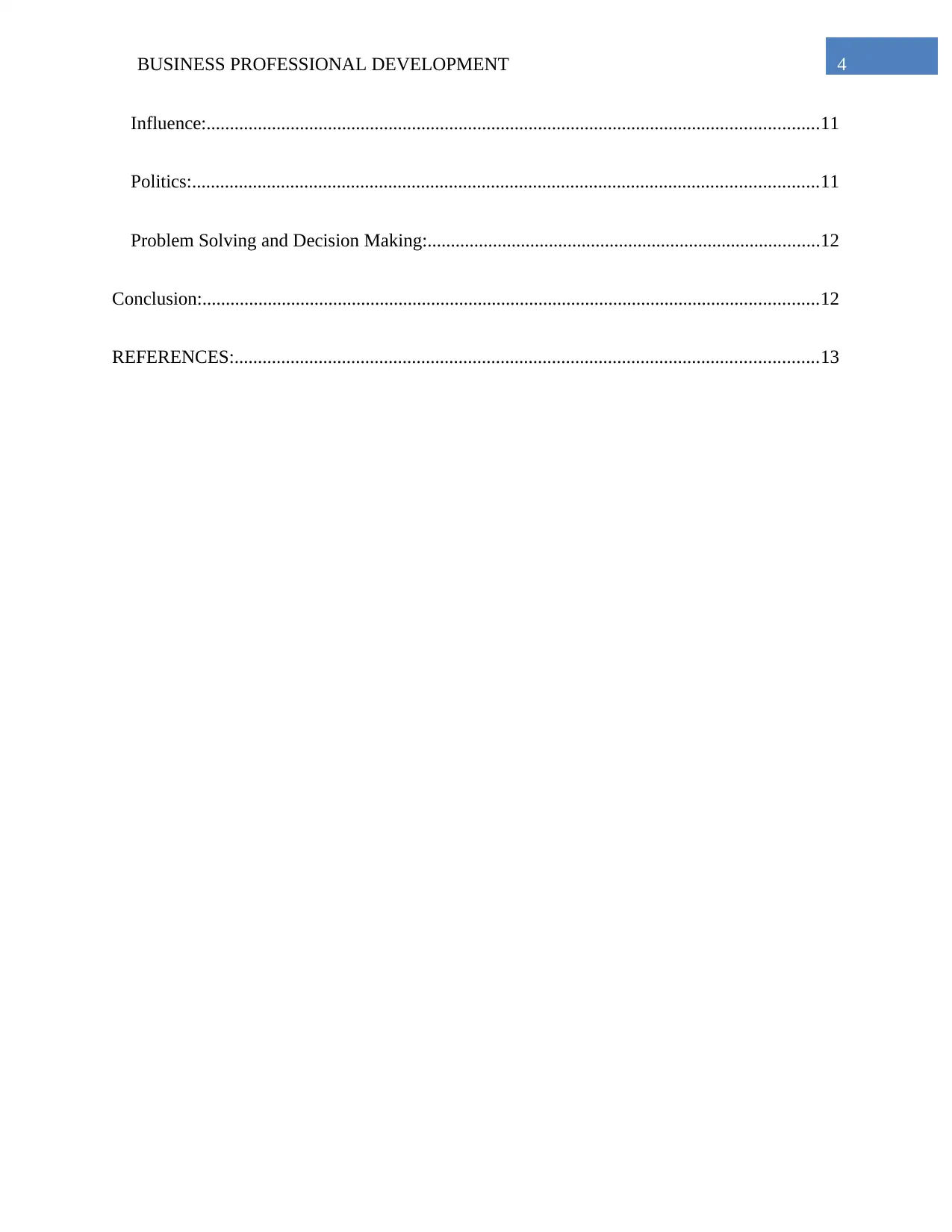
4BUSINESS PROFESSIONAL DEVELOPMENT
Influence:...................................................................................................................................11
Politics:......................................................................................................................................11
Problem Solving and Decision Making:....................................................................................12
Conclusion:....................................................................................................................................12
REFERENCES:.............................................................................................................................13
Influence:...................................................................................................................................11
Politics:......................................................................................................................................11
Problem Solving and Decision Making:....................................................................................12
Conclusion:....................................................................................................................................12
REFERENCES:.............................................................................................................................13
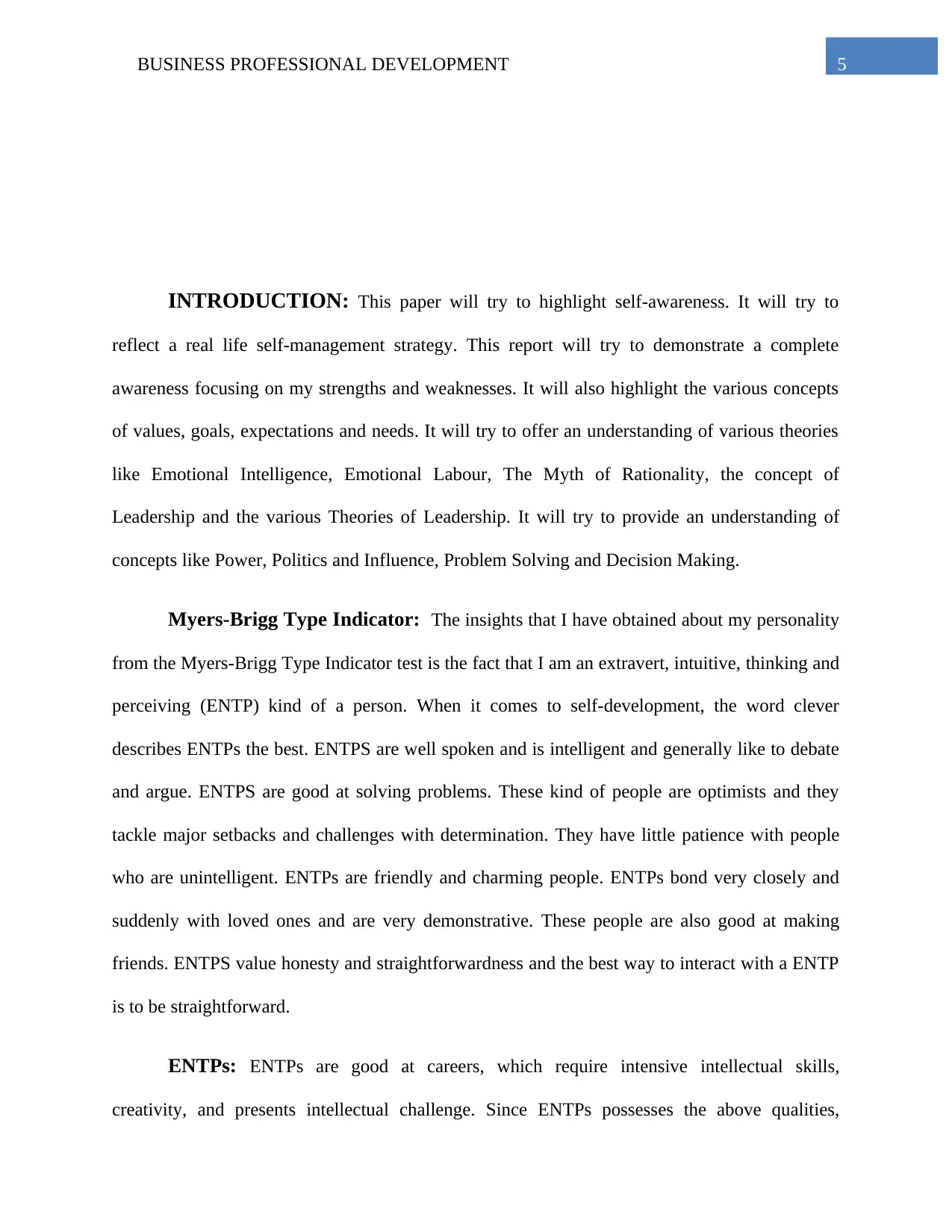
5BUSINESS PROFESSIONAL DEVELOPMENT
INTRODUCTION: This paper will try to highlight self-awareness. It will try to
reflect a real life self-management strategy. This report will try to demonstrate a complete
awareness focusing on my strengths and weaknesses. It will also highlight the various concepts
of values, goals, expectations and needs. It will try to offer an understanding of various theories
like Emotional Intelligence, Emotional Labour, The Myth of Rationality, the concept of
Leadership and the various Theories of Leadership. It will try to provide an understanding of
concepts like Power, Politics and Influence, Problem Solving and Decision Making.
Myers-Brigg Type Indicator: The insights that I have obtained about my personality
from the Myers-Brigg Type Indicator test is the fact that I am an extravert, intuitive, thinking and
perceiving (ENTP) kind of a person. When it comes to self-development, the word clever
describes ENTPs the best. ENTPS are well spoken and is intelligent and generally like to debate
and argue. ENTPS are good at solving problems. These kind of people are optimists and they
tackle major setbacks and challenges with determination. They have little patience with people
who are unintelligent. ENTPs are friendly and charming people. ENTPs bond very closely and
suddenly with loved ones and are very demonstrative. These people are also good at making
friends. ENTPS value honesty and straightforwardness and the best way to interact with a ENTP
is to be straightforward.
ENTPs: ENTPs are good at careers, which require intensive intellectual skills,
creativity, and presents intellectual challenge. Since ENTPs possesses the above qualities,
INTRODUCTION: This paper will try to highlight self-awareness. It will try to
reflect a real life self-management strategy. This report will try to demonstrate a complete
awareness focusing on my strengths and weaknesses. It will also highlight the various concepts
of values, goals, expectations and needs. It will try to offer an understanding of various theories
like Emotional Intelligence, Emotional Labour, The Myth of Rationality, the concept of
Leadership and the various Theories of Leadership. It will try to provide an understanding of
concepts like Power, Politics and Influence, Problem Solving and Decision Making.
Myers-Brigg Type Indicator: The insights that I have obtained about my personality
from the Myers-Brigg Type Indicator test is the fact that I am an extravert, intuitive, thinking and
perceiving (ENTP) kind of a person. When it comes to self-development, the word clever
describes ENTPs the best. ENTPS are well spoken and is intelligent and generally like to debate
and argue. ENTPS are good at solving problems. These kind of people are optimists and they
tackle major setbacks and challenges with determination. They have little patience with people
who are unintelligent. ENTPs are friendly and charming people. ENTPs bond very closely and
suddenly with loved ones and are very demonstrative. These people are also good at making
friends. ENTPS value honesty and straightforwardness and the best way to interact with a ENTP
is to be straightforward.
ENTPs: ENTPs are good at careers, which require intensive intellectual skills,
creativity, and presents intellectual challenge. Since ENTPs possesses the above qualities,
⊘ This is a preview!⊘
Do you want full access?
Subscribe today to unlock all pages.

Trusted by 1+ million students worldwide
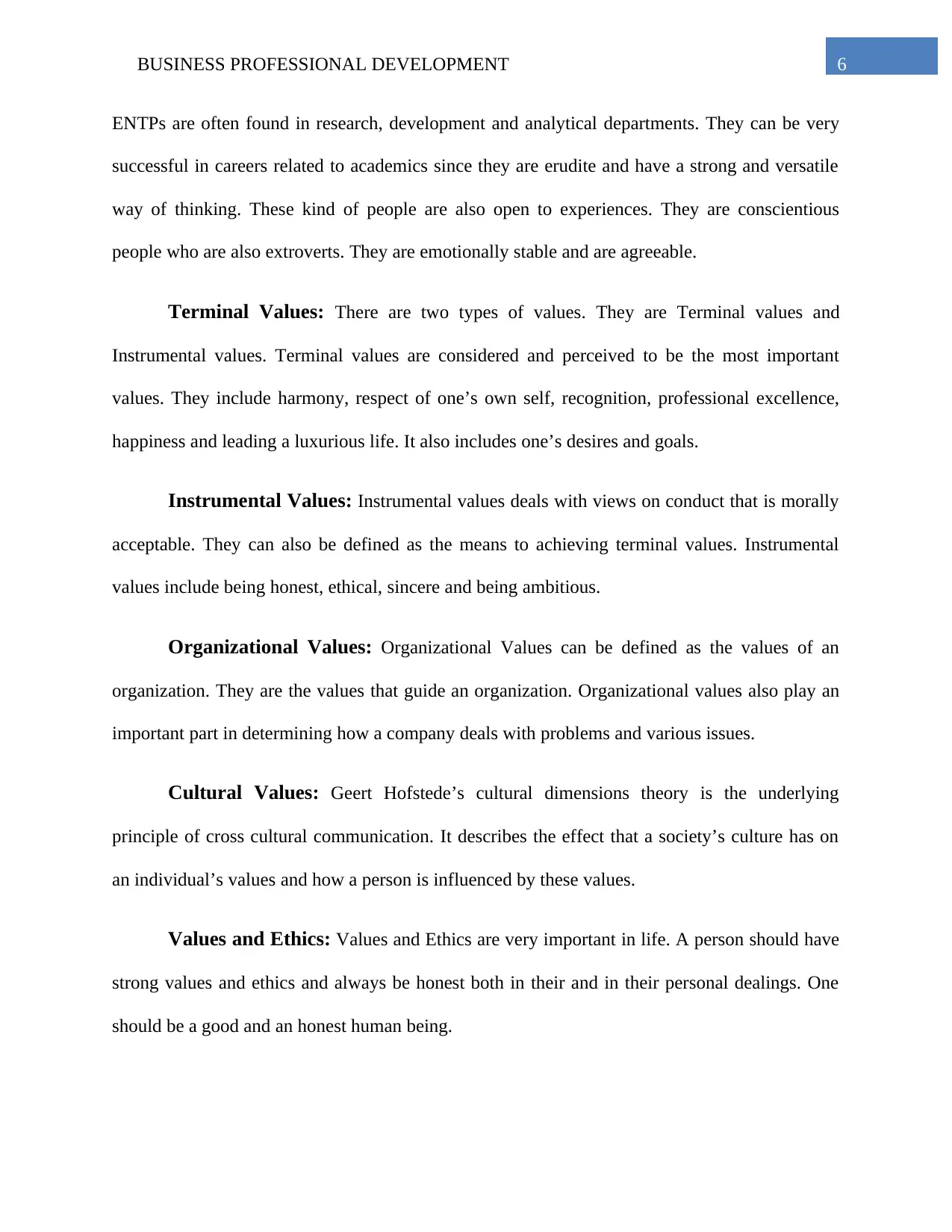
6BUSINESS PROFESSIONAL DEVELOPMENT
ENTPs are often found in research, development and analytical departments. They can be very
successful in careers related to academics since they are erudite and have a strong and versatile
way of thinking. These kind of people are also open to experiences. They are conscientious
people who are also extroverts. They are emotionally stable and are agreeable.
Terminal Values: There are two types of values. They are Terminal values and
Instrumental values. Terminal values are considered and perceived to be the most important
values. They include harmony, respect of one’s own self, recognition, professional excellence,
happiness and leading a luxurious life. It also includes one’s desires and goals.
Instrumental Values: Instrumental values deals with views on conduct that is morally
acceptable. They can also be defined as the means to achieving terminal values. Instrumental
values include being honest, ethical, sincere and being ambitious.
Organizational Values: Organizational Values can be defined as the values of an
organization. They are the values that guide an organization. Organizational values also play an
important part in determining how a company deals with problems and various issues.
Cultural Values: Geert Hofstede’s cultural dimensions theory is the underlying
principle of cross cultural communication. It describes the effect that a society’s culture has on
an individual’s values and how a person is influenced by these values.
Values and Ethics: Values and Ethics are very important in life. A person should have
strong values and ethics and always be honest both in their and in their personal dealings. One
should be a good and an honest human being.
ENTPs are often found in research, development and analytical departments. They can be very
successful in careers related to academics since they are erudite and have a strong and versatile
way of thinking. These kind of people are also open to experiences. They are conscientious
people who are also extroverts. They are emotionally stable and are agreeable.
Terminal Values: There are two types of values. They are Terminal values and
Instrumental values. Terminal values are considered and perceived to be the most important
values. They include harmony, respect of one’s own self, recognition, professional excellence,
happiness and leading a luxurious life. It also includes one’s desires and goals.
Instrumental Values: Instrumental values deals with views on conduct that is morally
acceptable. They can also be defined as the means to achieving terminal values. Instrumental
values include being honest, ethical, sincere and being ambitious.
Organizational Values: Organizational Values can be defined as the values of an
organization. They are the values that guide an organization. Organizational values also play an
important part in determining how a company deals with problems and various issues.
Cultural Values: Geert Hofstede’s cultural dimensions theory is the underlying
principle of cross cultural communication. It describes the effect that a society’s culture has on
an individual’s values and how a person is influenced by these values.
Values and Ethics: Values and Ethics are very important in life. A person should have
strong values and ethics and always be honest both in their and in their personal dealings. One
should be a good and an honest human being.
Paraphrase This Document
Need a fresh take? Get an instant paraphrase of this document with our AI Paraphraser
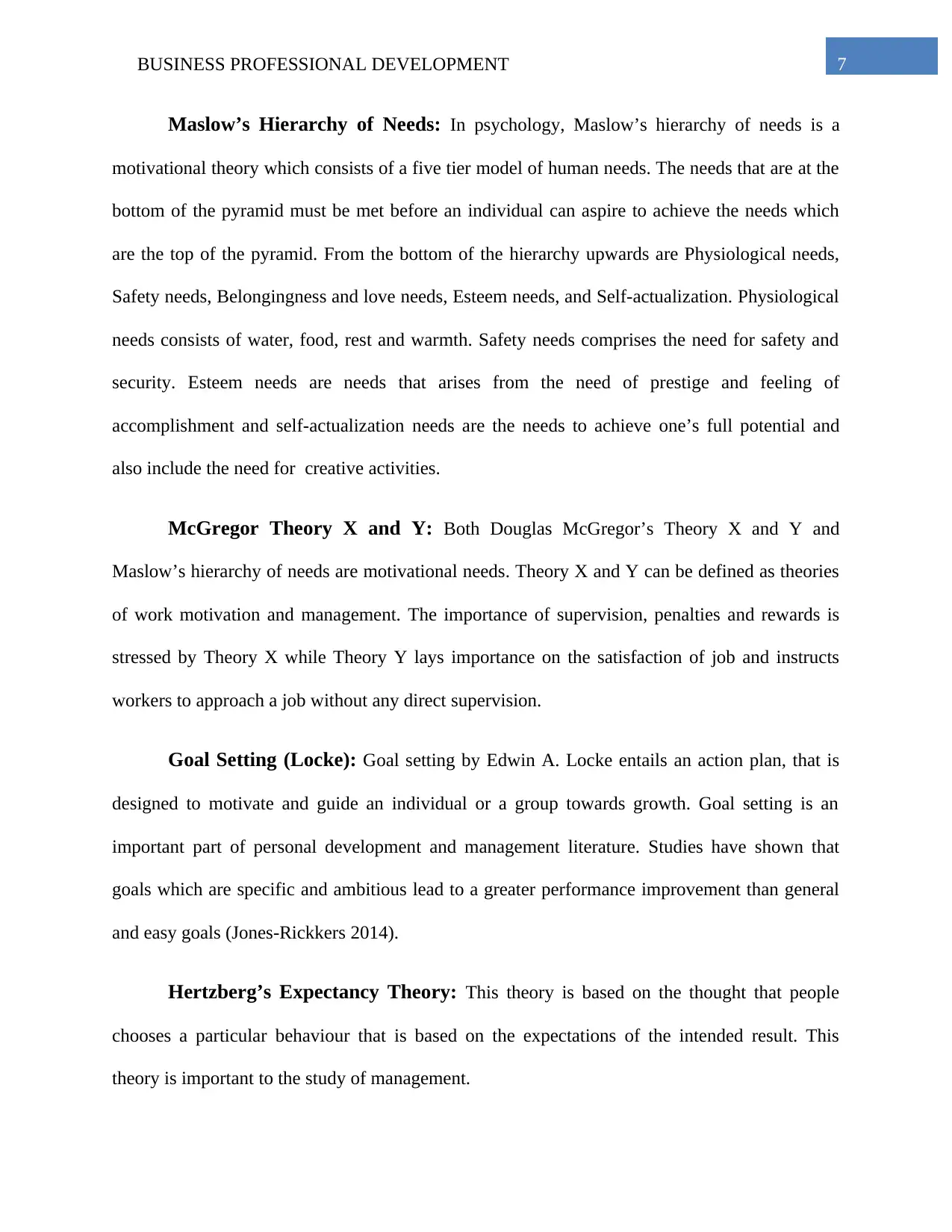
7BUSINESS PROFESSIONAL DEVELOPMENT
Maslow’s Hierarchy of Needs: In psychology, Maslow’s hierarchy of needs is a
motivational theory which consists of a five tier model of human needs. The needs that are at the
bottom of the pyramid must be met before an individual can aspire to achieve the needs which
are the top of the pyramid. From the bottom of the hierarchy upwards are Physiological needs,
Safety needs, Belongingness and love needs, Esteem needs, and Self-actualization. Physiological
needs consists of water, food, rest and warmth. Safety needs comprises the need for safety and
security. Esteem needs are needs that arises from the need of prestige and feeling of
accomplishment and self-actualization needs are the needs to achieve one’s full potential and
also include the need for creative activities.
McGregor Theory X and Y: Both Douglas McGregor’s Theory X and Y and
Maslow’s hierarchy of needs are motivational needs. Theory X and Y can be defined as theories
of work motivation and management. The importance of supervision, penalties and rewards is
stressed by Theory X while Theory Y lays importance on the satisfaction of job and instructs
workers to approach a job without any direct supervision.
Goal Setting (Locke): Goal setting by Edwin A. Locke entails an action plan, that is
designed to motivate and guide an individual or a group towards growth. Goal setting is an
important part of personal development and management literature. Studies have shown that
goals which are specific and ambitious lead to a greater performance improvement than general
and easy goals (Jones-Rickkers 2014).
Hertzberg’s Expectancy Theory: This theory is based on the thought that people
chooses a particular behaviour that is based on the expectations of the intended result. This
theory is important to the study of management.
Maslow’s Hierarchy of Needs: In psychology, Maslow’s hierarchy of needs is a
motivational theory which consists of a five tier model of human needs. The needs that are at the
bottom of the pyramid must be met before an individual can aspire to achieve the needs which
are the top of the pyramid. From the bottom of the hierarchy upwards are Physiological needs,
Safety needs, Belongingness and love needs, Esteem needs, and Self-actualization. Physiological
needs consists of water, food, rest and warmth. Safety needs comprises the need for safety and
security. Esteem needs are needs that arises from the need of prestige and feeling of
accomplishment and self-actualization needs are the needs to achieve one’s full potential and
also include the need for creative activities.
McGregor Theory X and Y: Both Douglas McGregor’s Theory X and Y and
Maslow’s hierarchy of needs are motivational needs. Theory X and Y can be defined as theories
of work motivation and management. The importance of supervision, penalties and rewards is
stressed by Theory X while Theory Y lays importance on the satisfaction of job and instructs
workers to approach a job without any direct supervision.
Goal Setting (Locke): Goal setting by Edwin A. Locke entails an action plan, that is
designed to motivate and guide an individual or a group towards growth. Goal setting is an
important part of personal development and management literature. Studies have shown that
goals which are specific and ambitious lead to a greater performance improvement than general
and easy goals (Jones-Rickkers 2014).
Hertzberg’s Expectancy Theory: This theory is based on the thought that people
chooses a particular behaviour that is based on the expectations of the intended result. This
theory is important to the study of management.
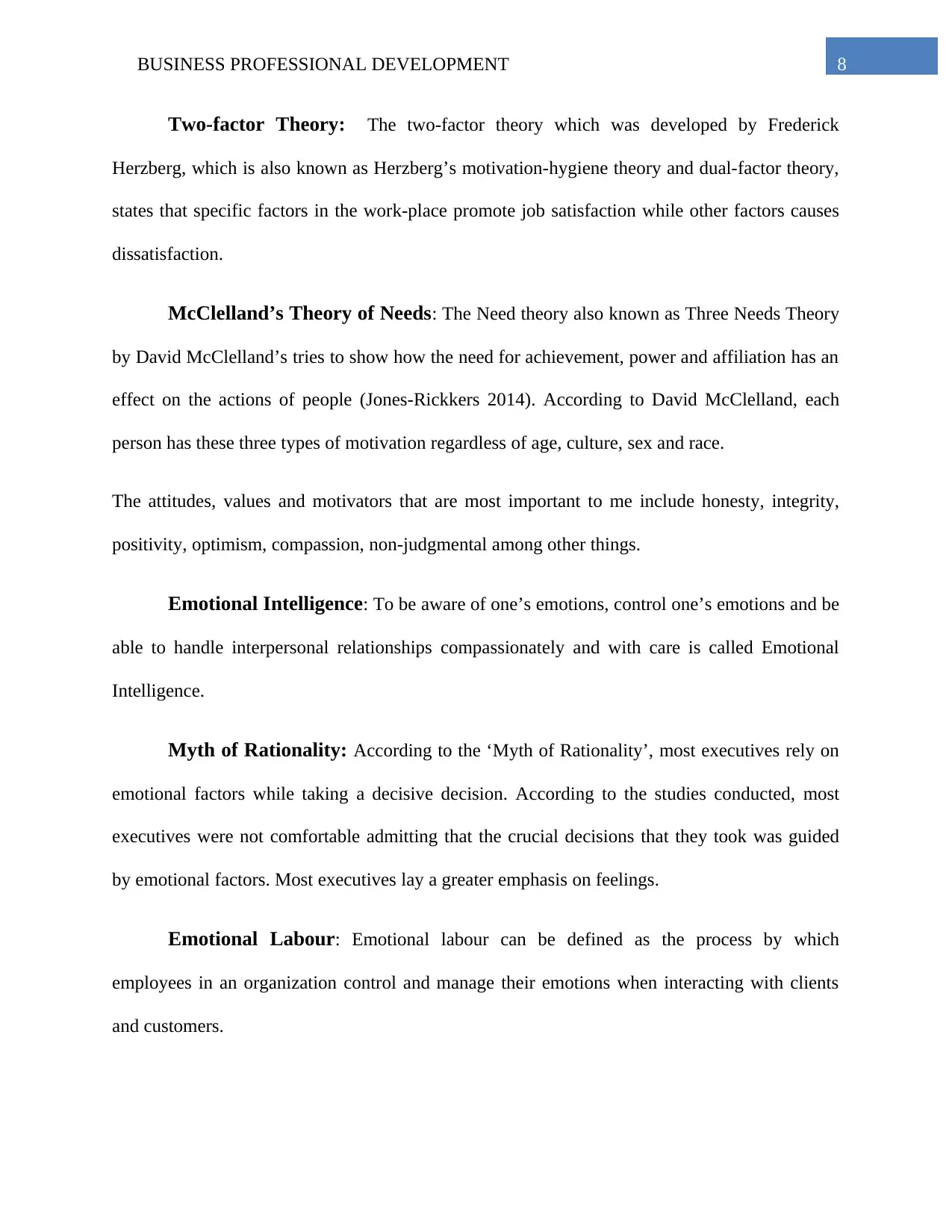
8BUSINESS PROFESSIONAL DEVELOPMENT
Two-factor Theory: The two-factor theory which was developed by Frederick
Herzberg, which is also known as Herzberg’s motivation-hygiene theory and dual-factor theory,
states that specific factors in the work-place promote job satisfaction while other factors causes
dissatisfaction.
McClelland’s Theory of Needs: The Need theory also known as Three Needs Theory
by David McClelland’s tries to show how the need for achievement, power and affiliation has an
effect on the actions of people (Jones-Rickkers 2014). According to David McClelland, each
person has these three types of motivation regardless of age, culture, sex and race.
The attitudes, values and motivators that are most important to me include honesty, integrity,
positivity, optimism, compassion, non-judgmental among other things.
Emotional Intelligence: To be aware of one’s emotions, control one’s emotions and be
able to handle interpersonal relationships compassionately and with care is called Emotional
Intelligence.
Myth of Rationality: According to the ‘Myth of Rationality’, most executives rely on
emotional factors while taking a decisive decision. According to the studies conducted, most
executives were not comfortable admitting that the crucial decisions that they took was guided
by emotional factors. Most executives lay a greater emphasis on feelings.
Emotional Labour: Emotional labour can be defined as the process by which
employees in an organization control and manage their emotions when interacting with clients
and customers.
Two-factor Theory: The two-factor theory which was developed by Frederick
Herzberg, which is also known as Herzberg’s motivation-hygiene theory and dual-factor theory,
states that specific factors in the work-place promote job satisfaction while other factors causes
dissatisfaction.
McClelland’s Theory of Needs: The Need theory also known as Three Needs Theory
by David McClelland’s tries to show how the need for achievement, power and affiliation has an
effect on the actions of people (Jones-Rickkers 2014). According to David McClelland, each
person has these three types of motivation regardless of age, culture, sex and race.
The attitudes, values and motivators that are most important to me include honesty, integrity,
positivity, optimism, compassion, non-judgmental among other things.
Emotional Intelligence: To be aware of one’s emotions, control one’s emotions and be
able to handle interpersonal relationships compassionately and with care is called Emotional
Intelligence.
Myth of Rationality: According to the ‘Myth of Rationality’, most executives rely on
emotional factors while taking a decisive decision. According to the studies conducted, most
executives were not comfortable admitting that the crucial decisions that they took was guided
by emotional factors. Most executives lay a greater emphasis on feelings.
Emotional Labour: Emotional labour can be defined as the process by which
employees in an organization control and manage their emotions when interacting with clients
and customers.
⊘ This is a preview!⊘
Do you want full access?
Subscribe today to unlock all pages.

Trusted by 1+ million students worldwide
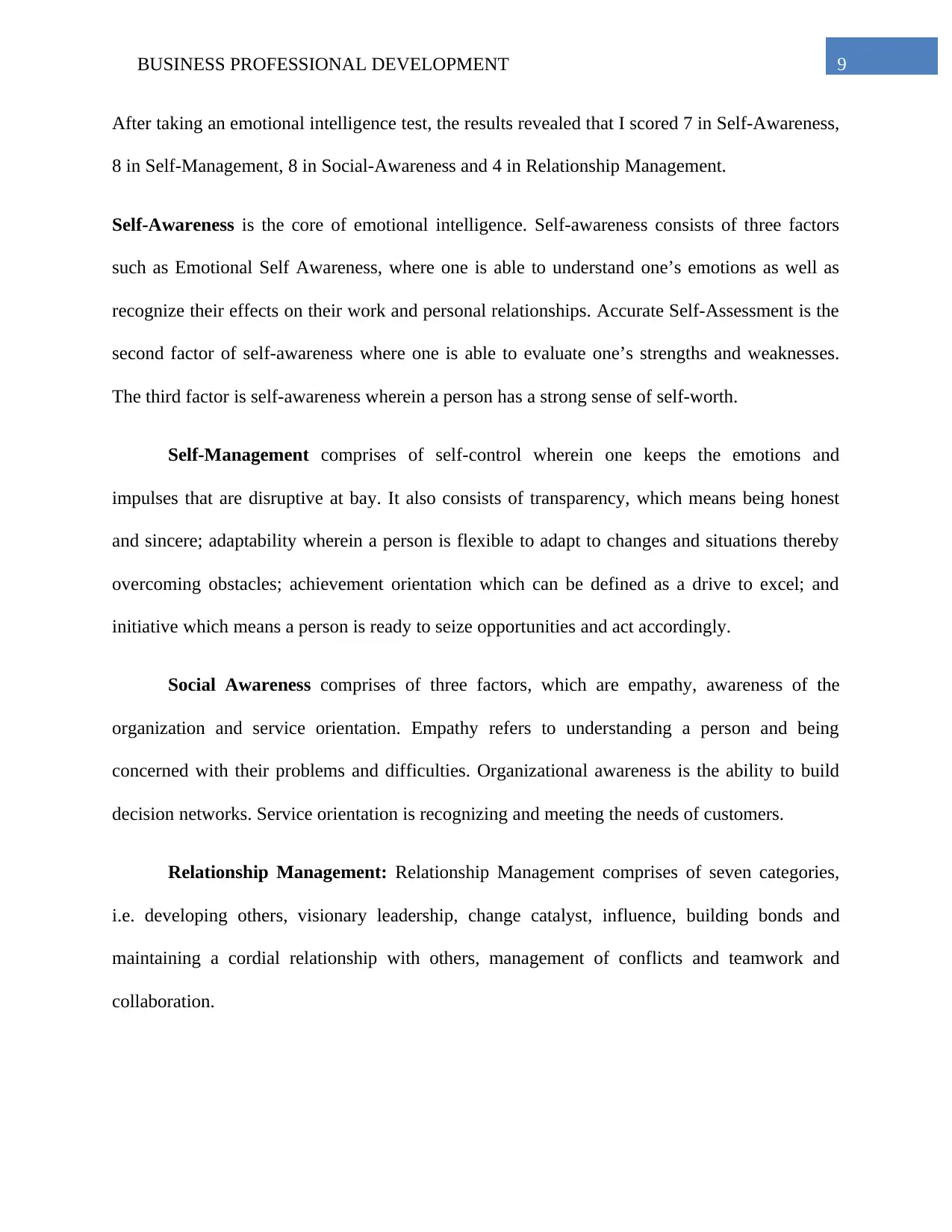
9BUSINESS PROFESSIONAL DEVELOPMENT
After taking an emotional intelligence test, the results revealed that I scored 7 in Self-Awareness,
8 in Self-Management, 8 in Social-Awareness and 4 in Relationship Management.
Self-Awareness is the core of emotional intelligence. Self-awareness consists of three factors
such as Emotional Self Awareness, where one is able to understand one’s emotions as well as
recognize their effects on their work and personal relationships. Accurate Self-Assessment is the
second factor of self-awareness where one is able to evaluate one’s strengths and weaknesses.
The third factor is self-awareness wherein a person has a strong sense of self-worth.
Self-Management comprises of self-control wherein one keeps the emotions and
impulses that are disruptive at bay. It also consists of transparency, which means being honest
and sincere; adaptability wherein a person is flexible to adapt to changes and situations thereby
overcoming obstacles; achievement orientation which can be defined as a drive to excel; and
initiative which means a person is ready to seize opportunities and act accordingly.
Social Awareness comprises of three factors, which are empathy, awareness of the
organization and service orientation. Empathy refers to understanding a person and being
concerned with their problems and difficulties. Organizational awareness is the ability to build
decision networks. Service orientation is recognizing and meeting the needs of customers.
Relationship Management: Relationship Management comprises of seven categories,
i.e. developing others, visionary leadership, change catalyst, influence, building bonds and
maintaining a cordial relationship with others, management of conflicts and teamwork and
collaboration.
After taking an emotional intelligence test, the results revealed that I scored 7 in Self-Awareness,
8 in Self-Management, 8 in Social-Awareness and 4 in Relationship Management.
Self-Awareness is the core of emotional intelligence. Self-awareness consists of three factors
such as Emotional Self Awareness, where one is able to understand one’s emotions as well as
recognize their effects on their work and personal relationships. Accurate Self-Assessment is the
second factor of self-awareness where one is able to evaluate one’s strengths and weaknesses.
The third factor is self-awareness wherein a person has a strong sense of self-worth.
Self-Management comprises of self-control wherein one keeps the emotions and
impulses that are disruptive at bay. It also consists of transparency, which means being honest
and sincere; adaptability wherein a person is flexible to adapt to changes and situations thereby
overcoming obstacles; achievement orientation which can be defined as a drive to excel; and
initiative which means a person is ready to seize opportunities and act accordingly.
Social Awareness comprises of three factors, which are empathy, awareness of the
organization and service orientation. Empathy refers to understanding a person and being
concerned with their problems and difficulties. Organizational awareness is the ability to build
decision networks. Service orientation is recognizing and meeting the needs of customers.
Relationship Management: Relationship Management comprises of seven categories,
i.e. developing others, visionary leadership, change catalyst, influence, building bonds and
maintaining a cordial relationship with others, management of conflicts and teamwork and
collaboration.
Paraphrase This Document
Need a fresh take? Get an instant paraphrase of this document with our AI Paraphraser
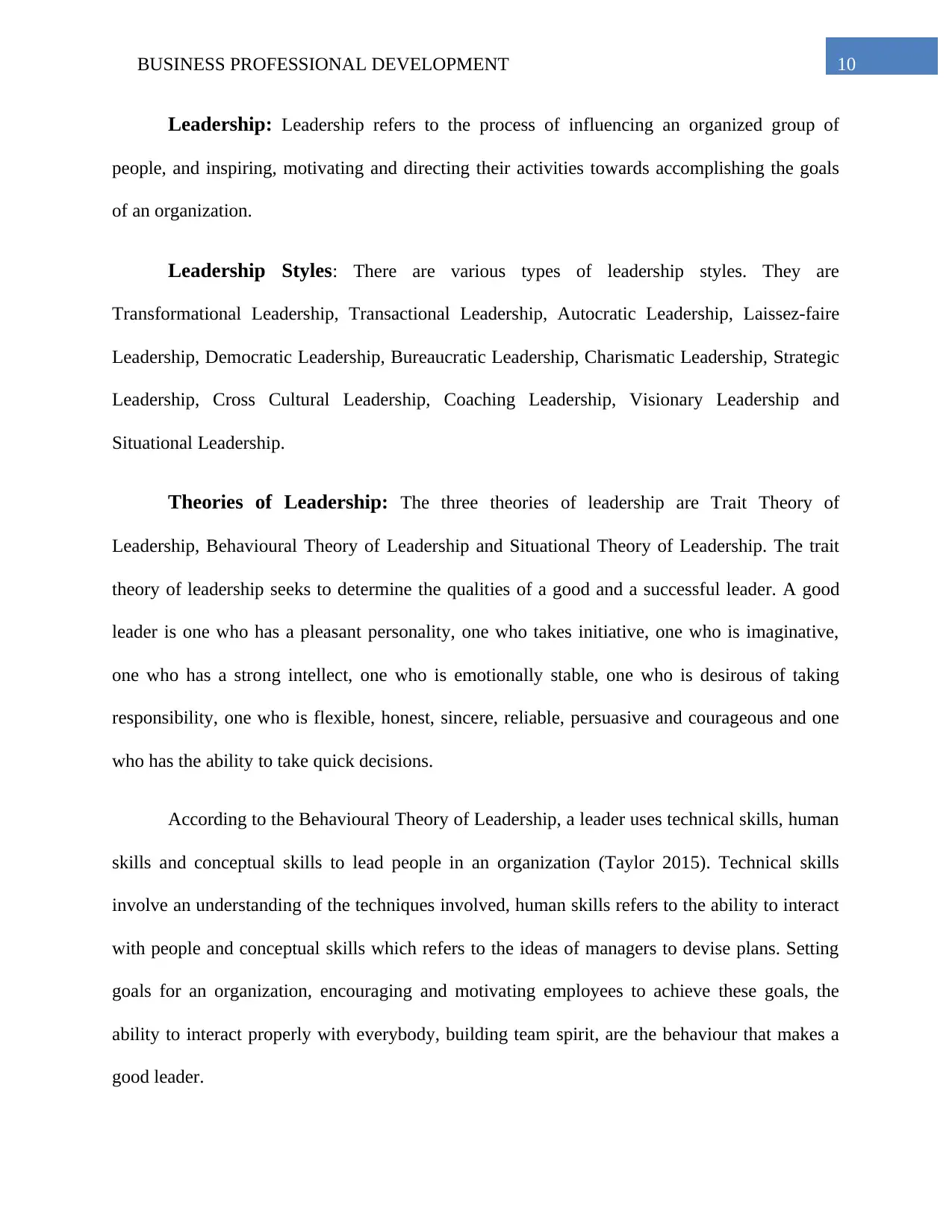
10BUSINESS PROFESSIONAL DEVELOPMENT
Leadership: Leadership refers to the process of influencing an organized group of
people, and inspiring, motivating and directing their activities towards accomplishing the goals
of an organization.
Leadership Styles: There are various types of leadership styles. They are
Transformational Leadership, Transactional Leadership, Autocratic Leadership, Laissez-faire
Leadership, Democratic Leadership, Bureaucratic Leadership, Charismatic Leadership, Strategic
Leadership, Cross Cultural Leadership, Coaching Leadership, Visionary Leadership and
Situational Leadership.
Theories of Leadership: The three theories of leadership are Trait Theory of
Leadership, Behavioural Theory of Leadership and Situational Theory of Leadership. The trait
theory of leadership seeks to determine the qualities of a good and a successful leader. A good
leader is one who has a pleasant personality, one who takes initiative, one who is imaginative,
one who has a strong intellect, one who is emotionally stable, one who is desirous of taking
responsibility, one who is flexible, honest, sincere, reliable, persuasive and courageous and one
who has the ability to take quick decisions.
According to the Behavioural Theory of Leadership, a leader uses technical skills, human
skills and conceptual skills to lead people in an organization (Taylor 2015). Technical skills
involve an understanding of the techniques involved, human skills refers to the ability to interact
with people and conceptual skills which refers to the ideas of managers to devise plans. Setting
goals for an organization, encouraging and motivating employees to achieve these goals, the
ability to interact properly with everybody, building team spirit, are the behaviour that makes a
good leader.
Leadership: Leadership refers to the process of influencing an organized group of
people, and inspiring, motivating and directing their activities towards accomplishing the goals
of an organization.
Leadership Styles: There are various types of leadership styles. They are
Transformational Leadership, Transactional Leadership, Autocratic Leadership, Laissez-faire
Leadership, Democratic Leadership, Bureaucratic Leadership, Charismatic Leadership, Strategic
Leadership, Cross Cultural Leadership, Coaching Leadership, Visionary Leadership and
Situational Leadership.
Theories of Leadership: The three theories of leadership are Trait Theory of
Leadership, Behavioural Theory of Leadership and Situational Theory of Leadership. The trait
theory of leadership seeks to determine the qualities of a good and a successful leader. A good
leader is one who has a pleasant personality, one who takes initiative, one who is imaginative,
one who has a strong intellect, one who is emotionally stable, one who is desirous of taking
responsibility, one who is flexible, honest, sincere, reliable, persuasive and courageous and one
who has the ability to take quick decisions.
According to the Behavioural Theory of Leadership, a leader uses technical skills, human
skills and conceptual skills to lead people in an organization (Taylor 2015). Technical skills
involve an understanding of the techniques involved, human skills refers to the ability to interact
with people and conceptual skills which refers to the ideas of managers to devise plans. Setting
goals for an organization, encouraging and motivating employees to achieve these goals, the
ability to interact properly with everybody, building team spirit, are the behaviour that makes a
good leader.
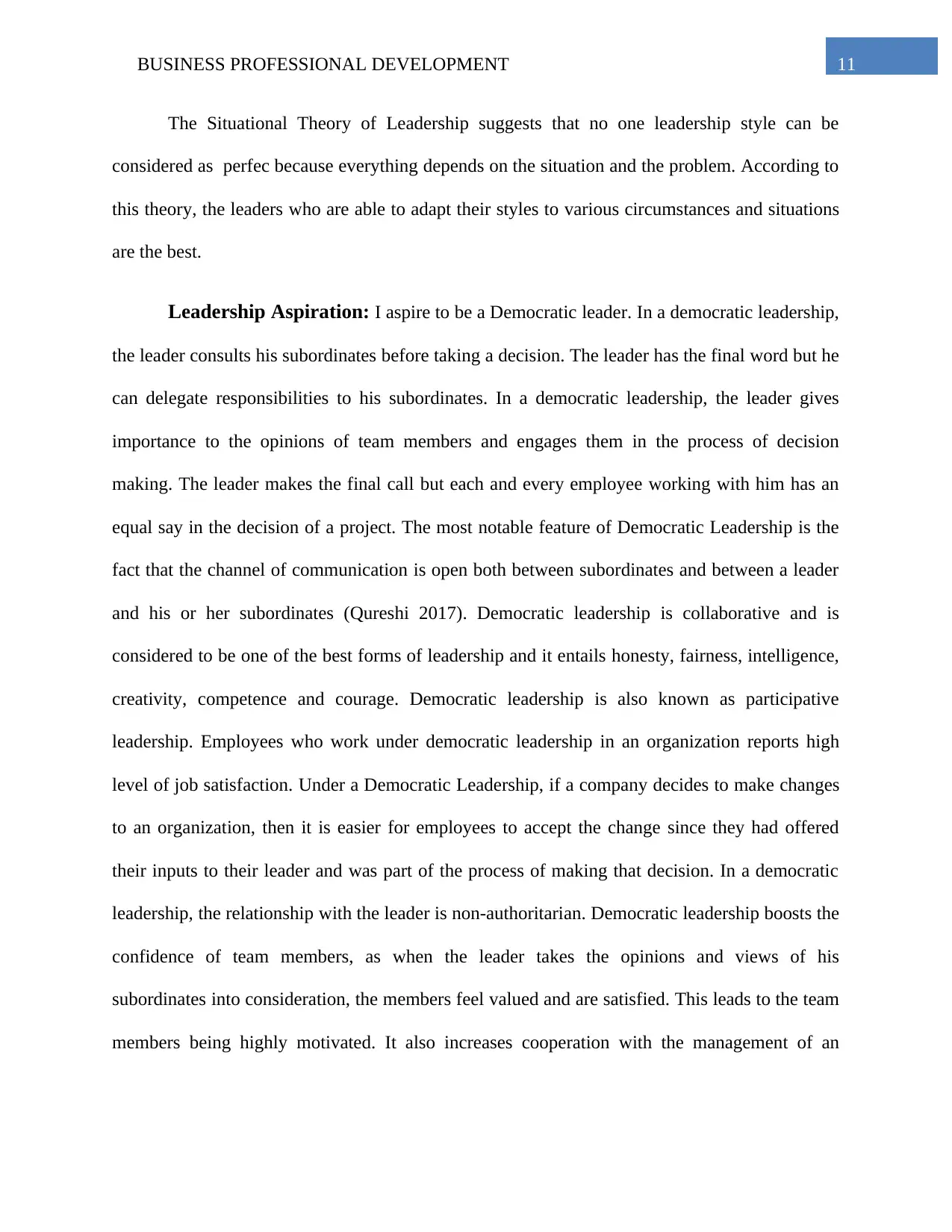
11BUSINESS PROFESSIONAL DEVELOPMENT
The Situational Theory of Leadership suggests that no one leadership style can be
considered as perfec because everything depends on the situation and the problem. According to
this theory, the leaders who are able to adapt their styles to various circumstances and situations
are the best.
Leadership Aspiration: I aspire to be a Democratic leader. In a democratic leadership,
the leader consults his subordinates before taking a decision. The leader has the final word but he
can delegate responsibilities to his subordinates. In a democratic leadership, the leader gives
importance to the opinions of team members and engages them in the process of decision
making. The leader makes the final call but each and every employee working with him has an
equal say in the decision of a project. The most notable feature of Democratic Leadership is the
fact that the channel of communication is open both between subordinates and between a leader
and his or her subordinates (Qureshi 2017). Democratic leadership is collaborative and is
considered to be one of the best forms of leadership and it entails honesty, fairness, intelligence,
creativity, competence and courage. Democratic leadership is also known as participative
leadership. Employees who work under democratic leadership in an organization reports high
level of job satisfaction. Under a Democratic Leadership, if a company decides to make changes
to an organization, then it is easier for employees to accept the change since they had offered
their inputs to their leader and was part of the process of making that decision. In a democratic
leadership, the relationship with the leader is non-authoritarian. Democratic leadership boosts the
confidence of team members, as when the leader takes the opinions and views of his
subordinates into consideration, the members feel valued and are satisfied. This leads to the team
members being highly motivated. It also increases cooperation with the management of an
The Situational Theory of Leadership suggests that no one leadership style can be
considered as perfec because everything depends on the situation and the problem. According to
this theory, the leaders who are able to adapt their styles to various circumstances and situations
are the best.
Leadership Aspiration: I aspire to be a Democratic leader. In a democratic leadership,
the leader consults his subordinates before taking a decision. The leader has the final word but he
can delegate responsibilities to his subordinates. In a democratic leadership, the leader gives
importance to the opinions of team members and engages them in the process of decision
making. The leader makes the final call but each and every employee working with him has an
equal say in the decision of a project. The most notable feature of Democratic Leadership is the
fact that the channel of communication is open both between subordinates and between a leader
and his or her subordinates (Qureshi 2017). Democratic leadership is collaborative and is
considered to be one of the best forms of leadership and it entails honesty, fairness, intelligence,
creativity, competence and courage. Democratic leadership is also known as participative
leadership. Employees who work under democratic leadership in an organization reports high
level of job satisfaction. Under a Democratic Leadership, if a company decides to make changes
to an organization, then it is easier for employees to accept the change since they had offered
their inputs to their leader and was part of the process of making that decision. In a democratic
leadership, the relationship with the leader is non-authoritarian. Democratic leadership boosts the
confidence of team members, as when the leader takes the opinions and views of his
subordinates into consideration, the members feel valued and are satisfied. This leads to the team
members being highly motivated. It also increases cooperation with the management of an
⊘ This is a preview!⊘
Do you want full access?
Subscribe today to unlock all pages.

Trusted by 1+ million students worldwide
1 out of 17
Related Documents
Your All-in-One AI-Powered Toolkit for Academic Success.
+13062052269
info@desklib.com
Available 24*7 on WhatsApp / Email
![[object Object]](/_next/static/media/star-bottom.7253800d.svg)
Unlock your academic potential
Copyright © 2020–2025 A2Z Services. All Rights Reserved. Developed and managed by ZUCOL.



